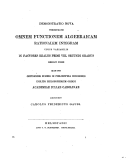How Language Obfuscates
That this subject [of imaginary magnitudes] has hitherto been considered from the wrong point of view and surrounded by a mysterious obscurity, is to be attributed largely to an ill-adapted notation. If, for example, 1, -1, and the square root of -1 had been called direct, inverse and lateral units, instead of positive, negative and imaginary (or even impossible), such an obscurity would have been out of the question.
Notes:
An example of how we name numbers taints our ability to solve or conceptualize certain problems.
Folksonomies: mathematics language
Taxonomies:
/art and entertainment/visual art and design/design (0.245289)
/family and parenting/children (0.203216)
/business and industrial (0.176489)
Keywords:
Obfuscates An example (0.966311 (negative:-0.749621)), imaginary magnitudes (0.956353 (negative:-0.504047)), mysterious obscurity (0.955192 (negative:-0.276774)), certain problems (0.785136 (negative:-0.749621)), square root (0.729086 (neutral:0.000000)), wrong point (0.724469 (negative:-0.276774)), lateral units (0.716780 (neutral:0.000000)), ill-adapted notation (0.706754 (neutral:0.000000))
Concepts:
Real number (0.984380): dbpedia | freebase | opencyc
Continuous function (0.876507): dbpedia | freebase | yago
Imaginary unit (0.816369): dbpedia | freebase | opencyc | yago
Complex number (0.804859): dbpedia | freebase | opencyc
Han Dynasty (0.765943): dbpedia | freebase | yago
Problem solving (0.728431): dbpedia | freebase
Square root (0.722951): dbpedia | freebase
Integer (0.662143): dbpedia | freebase | opencyc





